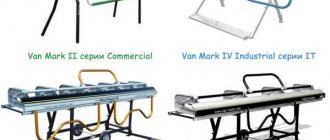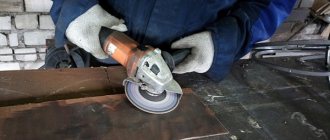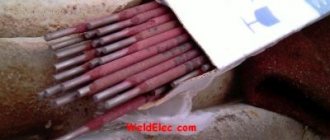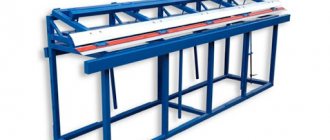Hands from the right place | 01/08/2018
When cold bending thin steel sheets or wide strips, the bending moments of the process are relatively small. Moreover, this applies to cases when plastic materials such as tin or aluminum are subjected to bending. Therefore, for small-scale production conditions, it is not advisable to purchase bulky drive sheet benders with mechanical and hydraulic drives. It is enough to use a structurally simpler manual sheet bender.
Sheet metal bending methods
Structurally, two bending options are possible - force and moment. In the first case, so-called calibrating sheet bending machines are used, which operate according to the classical scheme, with the presence of punches and dies. For the case of bending along a straight contour, such a tool can be segmented, when its individual parts are placed at a certain interval along the bending line: this saves setup time and reduces the weight of the machine.
Free bending, which uses a universal non-profiled tool, is based on the use of roller matrices, which, rotating when the bending body is rotated, perform deformation. Such a tool is more versatile and simple, and moment bending requires significantly less effort from the operator. The disadvantage of this method is the lower accuracy of the finished product.
A number of models of the equipment under consideration are equipped with additional positions, for example, with a cutting machine, which is used after bending. This allows you to make precise products “to size”, taking into account the part of the metal required for shaping the radius transitions.
According to the above varieties, two types of manual bending equipment are produced - manual sheet benders of the LGS series (calibrating bending with a profiled tool) and manual sheet benders from the brands Bender (Denmark), Tapco (USA) or MetallMaster (Poland), which are equipped with roller dies.
Both types of manual sheet bending machines are compact, easy to operate and set up, and are distinguished by fairly large technological capabilities. The drive can be controlled using a lever system or a pedal (the latter is used when bending wide sheets).
How to choose a machine?
The choice of machine is influenced by various factors that need to be taken into account when purchasing them. For one-time work, a portable manual machine is sufficient. With a constant need for equipment, you need to approach its selection more thoroughly. An important characteristic of machines that determines their choice is the maximum permissible thickness of the metal sheets used for bending and their size.
Manual sheet benders can easily handle metal sheets up to 2.5 mm thick. They are equipped with material feed levers and are light in weight. Manual sheet benders are indispensable in the production of non-standard profiles. To work with metal sheets with a thickness of more than 2.5 mm, electric machines are used. Thin-sheet galvanized or painted material 0.5-1.5 mm is bent using pneumatic equipment.
Expert opinion
Torsunov Pavel Maksimovich
Regular sheet metal up to 5 mm can be bent on hydraulic machines. For steel sheets and stainless steel up to 2.5 mm, mechanical equipment is well suited. The quality of work depends on the correct choice of equipment.
Segmental bending machines LGS series
Manual sheet bending machines of the LGS series produced by the Lipetsk Roll Forming Equipment Plant are aimed at use in the budget sector for the production of various roofing works. They allow installation in the open air, are easily reinstalled from place to place, are equipped with a cutting device, and the relatively small weight of the equipment allows them to be installed directly on the sites where profiled roofing is laid. The following models are widely used:
| Name sheet bender | Thickness of the original workpiece, mm, with the ultimate strength of the metal not exceeding 400 MPa | Maximum height of the folded shelf, mm | Maximum bending angle, degrees | Maximum width of the workpiece, mm | Bending capacity, min-1 | Machine weight, kg |
| LGS-26 | 0,4…0,4 | 15 | 135 | 900 | 2…3 | 150 |
| LGS-26u | 0,6…0,8 | 20 | 180 | 2200 | 2 | 165 |
| LGS-2500 | 0,6…0,8 | 30 | 180 | 300 | 2 | 204 |
From a design point of view, manual sheet benders LGS are horizontal machines with a translational (LGS-26, LGS-26u) or rotationally (LGS-2500) moving working beam. The welded frame of the machine is made of profiled steel and is characterized by sufficient rigidity, which allows for bending accuracy within ±0.15 mm, which is quite sufficient for roofing work. All versions are equipped with a cutting machine, with the help of which it is possible to ensure both cutting of the sheet according to one of its dimensions, and ensuring the final dimensions of the part after the main operation has been completed.
The drive of the LGS-26 and LGS-26u sheet benders is single-lever, with the operator holding the deformable workpiece on the table with his second hand. The LGS-2500 model requires control using two levers, so two people must operate this equipment.
A segmented tool with identical seating dimensions is attached to the lower plane of the bending beam. By arbitrarily placing it along the length of the beam, the worker ensures the best calibration of the bent workpiece in problematic situations (for example, if the material is of increased hardness, it is required to bend at a maximum angle, etc.).
After the adjustment of the bending punches is completed, the sheet workpiece is secured to the table using a rocker mechanism (maximum number of pressure points - 5), or - for budget models LGS-26 - with a screw clamp. Next, moving the bending beam, the metal is deformed. The process is visually controlled using a scale placed on the guides.
On the opposite side of the table there are cutting knives, with the help of which all separation transitions are made. The gap between the knives can be changed depending on the thickness of the source material, which helps to avoid burrs.
The LGS-2500 manual sheet bender operates in a similar way, only the working beam, when the lever is turned, makes a swinging movement rather than a translational one. This avoids a significant increase in the height and weight of the equipment.
In the sheet metal bending machine market, both manufacturers, Van Mark and Tapco, enjoy increased interest among users. Undoubtedly, some speak in favor of Tapco, others say that it is impossible to find better than Van Mark. Today we decided to conduct a practical comparative analysis, where we will consider the pros and cons of each of the sheet bending machines. It is worth noting that the entire analysis will be based on numerous reviews from clients of our company and the personal experience of specialists. As a result of the analysis, we will compare not only technical criteria, but also find out such an important indicator for many as quality-price.
Comparison of technical and design characteristics of models using the example of sheet bending machines Van Mark MM 851 and Tapco Max 20-08.
We selected sheet bending models with several equal parameters - the thickness of the processed metal sheet (0.7 mm) and its length (2600 mm). Despite the equivalence of these parameters, they have different depths for feeding the workpiece: the Van Mark MM 851 520 mm sheet bender, and the Tapco Max 20-08 sheet bender - 480 mm. As we can see, the sheet bender from Van Mark here, even if only by 40 mm, is ahead of its competitor. The advantage in the depth of material supply, of course, provides certain advantages, but there is one nuance in these models. The model from Van Mark, when clamping, moves the locking handle to the rear part of the machine, and in the model from Tapco it is moved to the front part, that is, it remains in the working area, creating certain inconvenience for the operator when bending. To be more precise, when you bend on Tapco, the workpiece being bent will rest against the handle of the pressing beam, thus it will be quite difficult to work with a wide workpiece. Since the Van Mark handle is moved away from the working area, such a defect is not observed on it.
A few more points regarding the clamping mechanism on Van Mark Mark and Tapco sheet benders.
When working on a manual sheet bending machine, you actually have two working areas - in the stump of the machine cavity and in the machine cavity. As we have already noted, the area outside the cavity of the Van Mark sheet bender is slightly larger than that of Tapco, which is ensured by moving the handle of the pressure beam away from the working area. This can be clearly seen in the figures below.
| Van Mark | Tapco |
It is also worth noting that sheet benders with a limited feed depth are used, as a rule, in the production of additional elements, where it is quite rare to find a product with a workpiece ream higher than 650-850 mm.
Design of the press brake mechanism.
The Tapco Max 20-08 sheet bender has a cam system that is adjusted using a conventional hex key; this action must be performed every time the machine is readjusted (that is, when the thickness of the metal sheet changes). If we consider the Van Mark MM 851 sheet bending machine, it uses an eccentric instead of a cam. This design solution makes it possible to work with metal of any thickness without readjusting the machine each time the workpiece is replaced. It is also important that the wear resistance, as practice has shown, of the cams is much lower than the eccentrics. As Tapco machine operators say, replacements have to be made approximately once every 1 to 1.5 years, and this is a waste of money, since costs range from $250 to $300/year on average. In Van Mark machines, only the substrates under the eccentrics, made of plastic, wear out, and they have to be replaced once every two or three years. The cost of such pads is no more than $20.
Difficulties when bending.
When bending metal on the Tapco Max 20-08, you must work with both hands at the same time, since if you pull the mechanism handle from one side, more force will be created in this area, which can damage not only the part, but also the machine. In addition, the result may be breakage of the handles. There are no such shortcomings on the Van Mark MM 851, because the bending mechanism handle is made in the form of a bracket and the load falls evenly during operation, regardless of whether you work with one hand or two.
Price criterion for sheet bending machines.
Price always plays an important role when choosing a machine, so it is simply impossible not to compare it. Van Mark MM 851 today costs 98,000 rubles, and Tapco Max 20-08, which does not differ in technical characteristics, costs 120,000 rubles. The difference is obvious! For some companies, the price difference of 22,000 rubles is a strong argument in favor of Van Mark.
Results.
So, summing up the results of the “race”, we can say with confidence that in terms of design and price, Van Mark MM 851 has become the clear leader of the race. It turned out to be not only profitable, but also economical. The popularity of the Tapco Max 20-08 sheet bender in Russia can be explained by only one thing - the company’s competent advertising and marketing policy. If you are looking for a reliable and durable sheet bending machine with similar characteristics, then here is the result, but the choice is yours!
Tips for use
- Care must be taken when working with metal. Minors and people without protective clothing should not be allowed into the equipment. Servicing of electric sheet benders is permitted only to persons with appropriate approvals.
- The quality of the bend is achieved by adjusting the rotary traverse. Excessive force when working with soft alloy materials has a negative impact on the final result of the work.
- It is necessary to install sheet bending machines on a solid, well-leveled base. For high-quality operation of the equipment, it is important to correctly adjust the clamping beam. The strength of the forces that will need to be exerted on the beam fixing the material depends on this.
- The cutting surface must always be exactly parallel to the traverse during operation.
Types of bending machines
To get a complete picture of how a sheet bending machine works, you need to understand how it works. This equipment includes components such as a table on which workpieces are placed. The workpiece will move along its surface in a given direction. In addition, a cutter can be installed on the table, cutting off the finished parts from the sheet of source material. A roller knife or saber guillotine can be used as a cutter.
Bending machine
The bending machines include a protractor. It is used to set the angle at which the sheet should be bent. In addition to this unit, limiters that regulate the maximum height of the resulting product play an important role. The working bending length and maximum metal thickness for each type of machine are strictly individual.
In practice, the following types of bending machines are used.
Manual metal bending equipment
Manual equipment is small in size and can be easily transported from one place to another. It is used in single production. Manual machines are used to produce parts made of different materials, for example, aluminum, copper, galvanized steel. Operating such a machine does not require any special training.
Electromechanical equipment for metal bending
Mechanical equipment uses the energy of a flywheel in its operation, which is spun specifically for this purpose. Machines with an electromechanical drive operate through a drive station, which includes an electric motor, gearbox, belts or chains. Hydraulic units operate from energy received from a hydraulic cylinder.
Hydraulic sheet bending machines
By the way, for gentle bending of sheets, especially those coated, sheet benders using compressed air are used. There are also devices such as electromagnetic ones. They are quite often used in the manufacture of boxes and boxes. The working tools in such equipment are powerful electromagnets, under the influence of which the sheet bends.
A separate class of bending equipment is portable (mobile); as a rule, they are used directly in the workplace, for example, on a construction site.
Design and scope of application of sheet metal bending machine
Machines for bending sheet metal are used in home workshops and factories. The devices have the same operating principle. Only the drive type changes. Bending machine design:
- The base that holds the desktop, movable mechanisms. This applies to models that are not fixed to workbenches.
- Pressing flywheels that hold the part during operation. Usually they are a metal plate.
- A wooden beam that acts as a cushion that acts as a support for the workpiece.
- Protractor for setting the desired angle.
- Stops limiting the sheet at the front and back.
Sheet benders are equipped with a special knife for cutting metal sheets. It is a separate tool that is mounted on the machine. The craftsman needs to make an effort to move it across the entire width of the workpiece. Sharp discs will cut thin sheet material to the specified size.
Sheet bending machines are used in various areas of industry:
Metal bending
The required result is obtained through metal deformation technology. When bending, the inner layer of the material is compressed and the outer one is stretched. In some ways, the bending operation is akin to straightening, the use of which eliminates defects - convexities and waviness.










